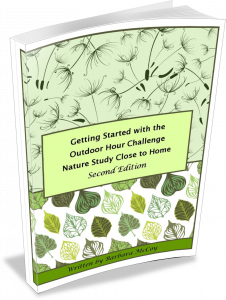If you have been following along with the challenges and you picked a focus way back in challenge number four, you should be just about ready to wrap up your first focus study. Our family has been learning about garden flowers but we are soon going to switch over to wildflowers. (This is going along with my son’s study of Kingdom plantae in biology.)
Please Note:If your family is enjoying your current focus, you do not need to switch but you can follow your own path and keep us posted.
Outdoor Hour Challenge #11
Begin a Four Season Tree Study
1. Read in the Handbook of Nature Study pages 622-623. Also read page 625, Spring Work. After reading, turn to the table of contents, to the tree section, and read the list of trees covered in this book. If possible, pick a tree from the list that you have in your yard, on your street, or in a near-by park that you can observe over the course of the next year. My boys and I have been working on a tree study with an oak tree since August 2007. The changes in the tree have given us something to study in each season. If you live in a more exotic location, like some participants who live in Australia, Brazil, or Spain, do your best to compare your tree to a similar tree in the Handbook of Nature Study. Many of the observations can be used to study a variety of trees.
Before heading out for your nature study time, read the introductory section for your focus tree with your children. Make sure to read the observation suggestions for your particular tree and keep these in mind as you go out to make your observations. You will be challenged in each season of the coming year to make an observation for your tree and record any changes. I have prepared a journal page to record your observations. See the end of the blog entry for a link to the journal page.
2. Take your 10-15 minute outdoor time to study the tree you are going to observe over the next year. We took photos of our tree to put in our nature journal or you can sketch them right into your journal. Keep in mind the suggestions for observation that you read in the Handbook of Nature Study. If you have younger children, just spend your time observing your tree and helping them to look at it closely.
3. Add anything new to your list of items observed in your focus area (challenge #4) that you are keeping in your nature journal. Make note of any additional research that needs to be done to follow up interest found during your Outdoor Hour.
4. Complete the Seasonal Tree Study journal page with your child. Place the page in your nature notebook to have for comparison in the next seasonal tree challenge.
You can purchase all of the first ten challenges in a convenient ebook along with custom notebook pages.













































